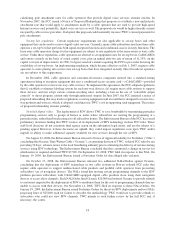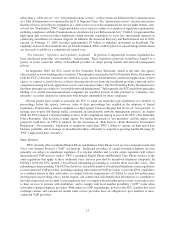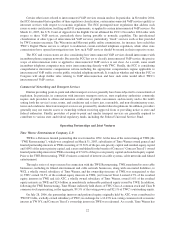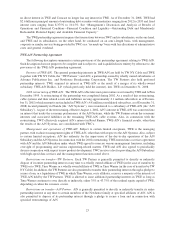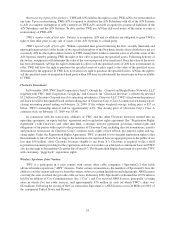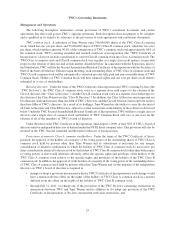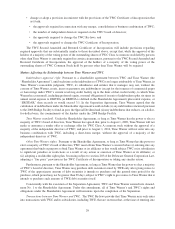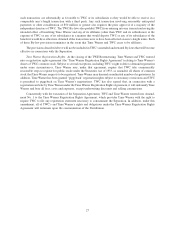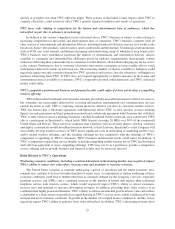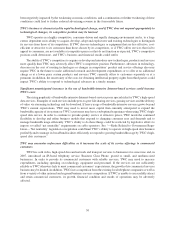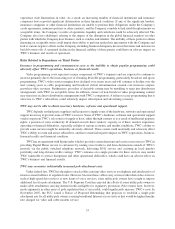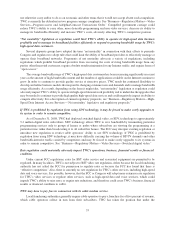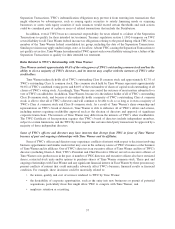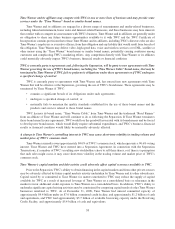Time Warner Cable 2008 Annual Report Download - page 38
Download and view the complete annual report
Please find page 38 of the 2008 Time Warner Cable annual report below. You can navigate through the pages in the report by either clicking on the pages listed below, or by using the keyword search tool below to find specific information within the annual report.Item 1A. Risk Factors.
Risks Related to Competition
TWC faces a wide range of competition, which could negatively affect its business and financial results.
TWC’s industry is, and will continue to be, highly competitive. Some of TWC’s principal competitors, DBS
operators and incumbent local telephone companies, in particular, offer services that provide features and functions
comparable to the video, high-speed data and/or voice services that TWC offers, and they offer them in bundles
similar to TWC’s. In a number of TWC’s operating areas, AT&T and Verizon have upgraded portions of their
networks to carry two-way video, high-speed data with substantial bandwidth and IP-based telephony services,
which they market and sell in bundles along with their wireless service. TWC’s competitors try to distinguish their
services from TWC’s by offering aggressive promotional pricing, exclusive programming, and/or assertions of
superior service or offerings.
In addition, TWC faces competition from a range of other competitors, including, increasingly, companies that
deliver content to consumers over the Internet, often without charging a fee for access to the content. This trend
could negatively impact customer demand for TWC’s video services, especially premium and On-Demand
services, and could encourage content owners to seek higher license fees from TWC in order to subsidize their
free distribution of content. TWC also faces competition in high speed data from second- and third-generation
wireless broadband services provided by mobile carriers such as Verizon, AT&T, Sprint and T-Mobile and
broadband over power lines. Competition in voice services is increasing as more homes in the United States are
replacing their traditional telephone service with wireless service.
Any inability to compete effectively or an increase in competition with respect to video, high-speed data or
voice services could have an adverse effect on TWC’s financial results and return on capital expenditures due to
possible increases in the cost of gaining and retaining subscribers and lower per subscriber revenue, could slow or
cause a decline in TWC’s growth rates, reduce TWC’s revenues, reduce the number of TWC’s subscribers and/or
reduce TWC’s ability to increase penetration rates for services. As TWC expands and introduces new and enhanced
services, TWC may be subject to competition from other providers of those services, such as telecommunications
providers, Internet Service Providers and consumer electronics companies, among others. TWC cannot predict the
extent to which this competition will affect its future business and financial results or return on capital expenditures.
Future advances in technology, as well as changes in the marketplace, in the economy and in the regulatory and
legislative environments, may result in changes to the competitive landscape. For additional information regarding
the regulatory and legal environment, see “—Risks Related to Government Regulation,” “—Risks Related to
TWC’s Operations—Weakening economic conditions, including a continued downturn in the housing market, may
negatively impact TWC’s ability to attract new subscribers, increase rates and maintain or increase revenues” and
“Business—Competition” and “—Regulatory Matters.”
TWC operates its cable systems under franchises that are non-exclusive. State and local franchising authorities
can grant additional franchises and foster additional competition.
TWC’s cable systems are constructed and operated under non-exclusive franchises granted by state or local
governmental authorities. Federal law prohibits franchising authorities from unreasonably denying requests for
additional franchises. Consequently, competing operators may build systems in areas in which TWC holds
franchises. The existence of more than one cable system operating in the same territory is referred to as an
“overbuild.” In the past, competing operators—most of them relatively small—have obtained such franchises and
offered competing services in some areas in which TWC holds franchises. More recently, incumbent local
telephone companies with significant resources, particularly Verizon and AT&T, have obtained such franchises in
order to offer video, high-speed data and voice services in some of TWC’s service areas. See “—TWC faces a wide
range of competition, which could negatively affect its business and financial results” above. Verizon and AT&T are
continuing to upgrade their networks to expand the geographic areas in which they can deliver video and high-speed
data services, in addition to their existing telephone services.
Increased competition from any source, including overbuilders, could require TWC to charge lower prices for
existing or future services than TWC otherwise might or require TWC to invest in or obtain additional services more
28


